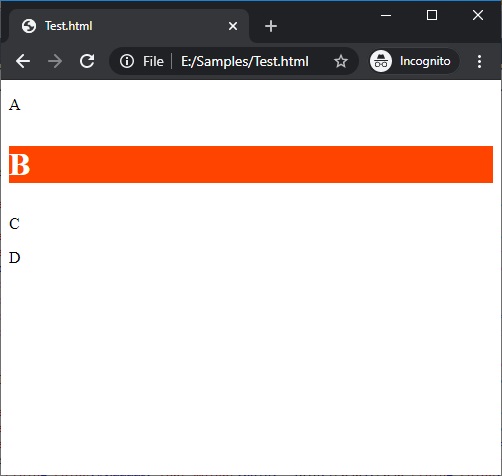css组合选择器
Combinators in CSS are used to explain a relationship between two selectors. A selector can be simple to complex and we can combine any two selectors through combinator.
CSS中的组合器用于解释两个选择器之间的关系。 选择器可以简单到复杂,我们可以通过组合器组合任意两个选择器。
There are four different combinators in CSS,
CSS中有四种不同的组合器 ,
General sibling selector (~)
通用同级选择器( 〜 )
Adjacent sibling selector (+)
相邻的同级选择器( + )
Child selector (>)
子选择器( > )
Descendant selector (space)
后代选择器( 空格 )
Let us understand these combinators one by one...
让我们一一理解这些组合器...
1)通用同级选择器(〜) (1) General sibling selector (~))
It is denoted by ~. The general sibling selector as its name suggests is useful to select the elements that are the sibling to a specified element. This can also be used to select the elements who share the same parent element.
用〜表示。 顾名思义,通用的同级选择器对于选择指定元素的同级元素很有用。 这也可以用于选择共享相同父元素的元素。
Syntax:
句法:
element1 ~ element2{
//CSS styling
}
Example:
例:
<!DOCTYPE html>
<html>
<head>
<style>
div ~ p {
font-weight: bold;
background-color: #f40;
color: #fff;
font-size: 32px;
}
</style>
</head>
<body>
<p>A</p>
<div>
<p>B</p>
</div>
<p>C</p>
<p>D</p>
</body>
</html>
Output
输出量

In the above example, two <p> are selected i.e. "C" and "D" because they are a sibling to specified element <div>.
在上面的示例中,选择了两个<p> ,即“ C”和“ D”,因为它们是指定元素<div>的同级。
2)相邻的兄弟选择器(+) (2) Adjacent sibling selector (+))
It is denoted by +. As its name suggests adjacent sibling selector is used to selecting the element that is adjacent to a specified element. This combinator only selects one element that is next to a specified tag.
用+表示。 顾名思义,相邻兄弟选择器用于选择与指定元素相邻的元素。 该组合器仅选择一个位于指定标签旁边的元素。
Syntax:
句法:
element1 + element2{
//CSS styling
}
Example:
例:
<!DOCTYPE html>
<html>
<head>
<style>
div + p {
font-weight: bold;
background-color: #f40;
color: #fff;
font-size: 32px;
}
</style>
</head>
<body>
<p>A</p>
<div>
<p>B</p>
</div>
<p>C</p>
<p>D</p>
</body>
</html>
Output
输出量
Output
输出量

In the above example, the <p> i.e. "C" is selected as it is a sibling to the specified element <div>.
在上面的示例中,选择<p>即“ C” ,因为它是指定元素<div>的同级。
3)子选择器(>) (3) Child selector (>))
It is denoted by >. The child selector selects all the elements that are children of a specified element. It can select more than one element.
用>表示。 子选择器选择所有属于指定元素的子元素。 它可以选择多个元素。
Syntax:
句法:
element1 > element2{
//CSS styling
}
Example:
例:
<!DOCTYPE html>
<html>
<head>
<style>
div > p {
font-weight: bold;
background-color: #f40;
color: #fff;
font-size: 32px;
}
</style>
</head>
<body>
<p>A</p>
<div>
<p>B</p>
</div>
<p>C</p>
<p>D</p>
</body>
</html>
Output
输出量

In the above example <p> element selected as it is a child of the specified element <div>.
在上面的示例中,选择的<p>元素是指定元素<div>的子元素。
4)后代选择器(空格) (4) Descendant selector (space))
It is denoted by space between two elements. The descendant selector selects all the elements that are descendant to a specified element. This combinator is useful to combine the two selectors such that selected elements have an ancestor the same as the first selector element.
用两个元素之间的间距表示。 后代选择器选择属于指定元素的所有后代元素。 该组合器可用于组合两个选择器,以使所选元素的祖先与第一个选择器元素相同。
Syntax:
句法:
element1 element2 {
//CSS styling
}
Example:
例:
<!DOCTYPE html>
<html>
<head>
<style>
div p {
font-weight: bold;
background-color: #f40;
color: #fff;
font-size: 32px;
}
</style>
</head>
<body>
<p>A</p>
<div>
<p>B</p>
</div>
<p>C</p>
<p>D</p>
</body>
</html>
Output
输出量

In the above example <p> is selected because it is a descendant of specified element <div>.
在上面的示例中,选择<p>是因为它是指定元素<div>的后代。
翻译自: https://www.includehelp.com/code-snippets/css-combinators.aspx
css组合选择器





















 978
978

 被折叠的 条评论
为什么被折叠?
被折叠的 条评论
为什么被折叠?








